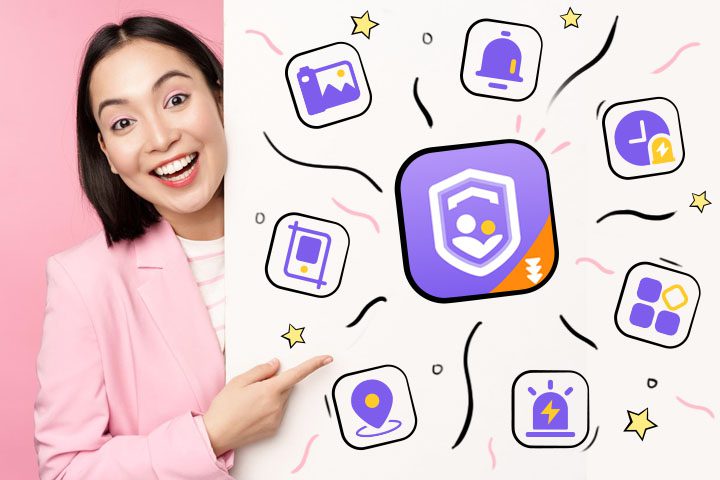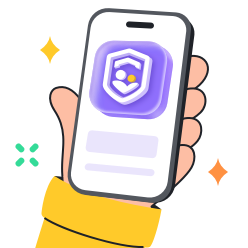If you even spend a little time online while scrolling social media, you will definitely come across a GIF. So, if you are wondering what is GIF? Then don’t worry, it’s not any application. Actually, they are just reduced image files in which you see the in loop motion to express emotions, or many more.
However, for a deep understanding, keep reading this blog as we’ll discuss in detail what GIFs are. And also how they are different from images/videos. Plus, we’ll tell why they are very famous among the kids or teens, or whether they are safe for them or not.
What is a GIF?
GIF (Graphics Interchange Format) is a highly compressed image file that can either be static or moving ( animated effect). Thus, allowing you to easily communicate with people online.
The images that you normally see online are in JPEG or PNG format and have only one frame, so they remain static. On the other hand, a GIF file may consist of multiple images (known as frames). And these you’ll see in order, one after another, according to the time set. Also when it reaches the last frame it again comes back to the first, thus you will see that it’s always in motion.
That’s why people mostly use such GIF files on social media platforms to show their reactions or emotions instead of sending a long video. Moreover, some also use them in their blogs to make people understand the complex working mechanism in short clips with animated visuals.



A brief history: How GIFs became popular online
The GIFs were first created in 1987 by the company named CompuServe (the first major online service provider). At that time, people were facing difficulties in sharing images online. This is because of their large size, and they also took a long time to load.
Thus, with the creation of GIF files, it becomes possible for people to easily display the pictures online and continue their work. That’s because they were very short files. As a result, they usually take small storage space and you can send them to others within seconds.
You know, at the start, people’s GIF format was just for static images. But soon people found that GIFs can also show animation effects just by adding multiple images. Thus, as soon as the Internet became popular in 1990, people also started using the GIF on their own personal websites.
Later on in the 2000’s with the rise of social media platforms, people realized that they can even use GIFs to show their laughter, excitement, etc, instead of creating a long video. Nowadays, you’ll find GIFs everywhere, like in memes, social media posts, and marketing and online messages.
Difference between GIFs and images/videos
Now, let’s have a quick look at how GIFs are different from image and video files in the table below!
| GIFs | Images | Videos | |
| Motion | Can be looping | Static, no motion | Moving, full motion |
| Sound | ✖ | ✖ | ✔ |
| File size | Small to medium (typically 10 KB to 1 MB; larger ones can be up to 50 MB) | Small to medium (JPEG: 10 KB to 2 MB; PNG: 50 KB to 2 MB) | Larger (SD: 1–2 GB; HD: 2–4 GB per hour) |
| Length/Duration | Short, loops repeatedly (typically under 10 seconds) | Single snapshot | Can be long or short (from seconds to hours) |
| Colors | Up to 256 colors per frame | JPEG: Millions of colors (full RGB); PNG: Millions of colors with transparency | Millions of colors (full RGB) |
| Use | Reactions, memes, short clips | Photos, graphics, illustrations | Movies, tutorials, full animations |
| Playback | Automatic loop | Viewed as a single image | Requires play/pause controls |
Why are GIFs so popular among kids and teens?
GIFs, because of their animation effect, look so stunning and eye-catching. As a result, most of the kids and teens use them in their online chatting and on social media. Let’s dive deeper and understand the other reasons for their popularity!
Autoplay looping: GIF has one of the amazing benefits that they play automatically once seen. It’s a fact that kids/teens can ignore the static images. However, the GIFs, because of their continuous movement, will definitely attract their attention.
Express emotions quickly: Furthermore, it’s a fact that you can’t express your feelings just by typing the message. Thus, you can share the GIF of laughter, excitement, etc, and truly express your emotions at that time. Also, the younger kids who are not yet able to express emotions in words can truly communicate with others.
Used in memes and social media: Also, nowadays, most of the kids and teens are seen active on social media platforms, sharing updates about their lives. Also, the Pew Research Center has conducted a survey in 2024 about the social media use by U.S teens. You would remain shocked to know that almost 48% of surveyed teens constantly use social media platforms.
You know that GIFs are a part of every online platform, like WhatsApp, TikTok, Instagram, Twitter, etc. Thus, these help kids or teens to show that they are also a part of that online community.
Lightweight and easy to share: Moreover, compared to videos, GIFs are very short in size. Thus, kids or teens would easily download. And share them on their mobile phones without getting worried about their storage space.
Creativity and personalization: In addition, there are many platforms available online that allow you to create GIFs from videos as you wish. Thus, this thing would help kids foster creativity. And they would better communicate with others, telling others in a fun way about themselves.
Cross-platform compatibility: Last but not least, almost all messaging apps or platforms support GIFs.
Monitor your child’s GIF interactions to guard against unsuitable content.
How to create and share a GIF?
If talking about the creation of GIF, then don’t worry! It’s just a piece of cake. As many websites are available on the Internet that allow you to do this within seconds. Let’s have a quick overview of such platforms for your ease!
Using GIF websites
GIPHY: It’s basically an American search engine that allows you to search and share GIFs, clips, memes, and many more by uploading your desired photos/videos. For instance,



Key features:
- You can also access millions of trending GIFs.
- It allows you to add text, stickers, filters, and drawings.
- Enables you to share directly to social media or messaging apps.
- It also has a searchable library by mood, reactions, or categories.
Tenor: This type of GIF search engine is actually owned by Google and has the GIF keyboard app. Thus, you can search the GIFs directly within the messaging apps and share them with your friends.
Imgur: Next, talking about Imgur, then it’s basically an online image-sharing community. In 2009, Alan Schaff actually founded it. It allows all of its users to upload images, memes, and GIFs.
Thus, you can download the popular GIFs from these platforms. And easily share them with your friends via WhatsApp, Instagram, or Snapchat. Well! You can share such GIFs in chats, post them in stories, or include them in comments. Thus making your conversations more engaging.
Are GIFs safe for kids?
Although GIFs are animated moving images that kids mostly use in their chats with friends to show their emotions, just like emojis. However, we can’t give you one one-word statement like they are safe or not for kids. To help you make a better decision, I’m discussing both its positive and negative aspects!
Positive uses of GIFs
Educational GIFs: The very most significant benefit of GIFs is that they are very helpful in making kids understand science experiments. Thus, kids would have no need to watch the long videos, which are quite irritating or boring.
Creative expression: Furthermore, kids can also create or personalize the GIF by adding text, stickers, etc. Thus, this customization allows kids to foster creativity among themselves.
Social interaction: Also, even if you are an adult, it’s definitely very difficult to express feelings in words. And kids even find it more difficult, thus the GIF allows them to freely interact wth their friends
Risks of GIFs
Explicit or offensive content: All GIFs shared on the Internet are not educational one some may have explicit content. Thus, early exposure to such harmful content would spoil the kids’ minds.
Cyberbullying: Also, some unknown persons or even peers may message your kids and share with them an offensive GIF. They usually do so to harass the kids, but the kids don’t tell anyone, and even go into trauma. Furthermore, some may even send the suspicious GIF links to the kids, and as they click, their accounts get hacked.
Addictive usage: Also, kids engage in online chatting with friends by sharing GIFs. And thus always remain in search of getting the trendy ones. As a result, they spend several hours scrolling through social media, ignoring their studies and other real-life activities.
There are many survey reports stating that social media platforms may have negative impacts on kids, and cyberbullying is one of them. You know, according to the Common Sense Media report, almost 45% of teens have been exposed to inappropriate content on Snapchat. And GIFs being a part of Snapchat also contribute to it.
How to protect children in the world of GIFs?
So you can say that if kids don’t remain conscious online, then they would have to suffer from the irreparable loss in the form of cyberbullying or many more.
So, being a parent, you should be actively involved in your kids’ digital activities. And openly talk to them to gain their trust. Guide them that if anything online is disturbing them, then share it with you. Tell them that you are always there to support them.
However, for complete peace of mind, it’s best to go for the third-party parental control tools. Happy to share with you that FlashGet Kids has succeeded because it combines the advanced monitoring features discussed below!



- App activity monitoring: Owing to this app, you would get a detailed summary report about what kind of apps your kids have used and for how long. Also, it allows you to see where your kids have shared the GIF.
- Screen time management: Furthermore, it also enables you to set time limitations on the usage of different social media platforms. Thus, resorting kids from excessive memes scrolling. And thus making them focus on their studies or other life-essential activities.
- Website/app blocking: Also, there is a possibility that your kids may use an inappropriate website for GIF creation. Thus, this app allows you to filter out the harmful URLs. And also restrict them from accessing any newly downloaded app without your permission.
- Real-time alerts: Moreover, FlashGet Kids also allows you to set the keywords related to inappropriate content in the social media apps. Thus, if kids try to use such words in their chats, then the app instantly sends an alert to the parents.
FAQs
Of course, you’ll face the copyright issue with the GIF if you share it online for commercial purposes without getting permission from the original creator.
Absolutely no, standard GIFs have no sound at all; you’ll just see the characters or images moving in a loop( one after the other).
You’ll find some GIFs in low quality because, first, they come in a reduced file size. And secondly, they have a 250 Colors per frame limitation, which also makes the image blurry.
In short, GIFs are a short and engaging way for kids or teens to express their feelings and gain educational benefits. However, they can also get exposed to explicit content via GIF or may bully online. So parental involvement is highly crucial to ensure they remain safe online.

